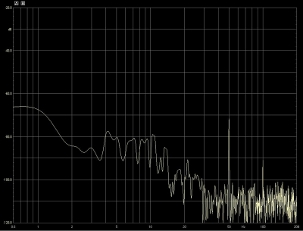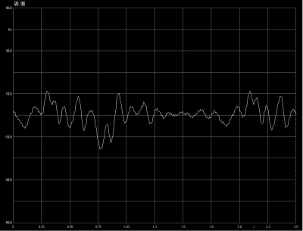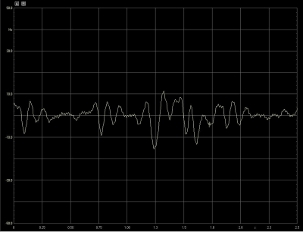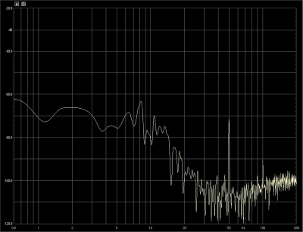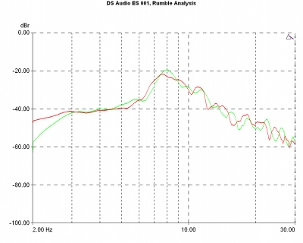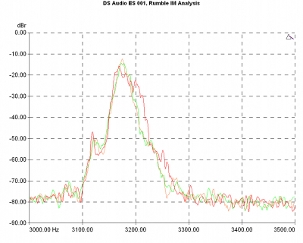about Audio, High Fidelity
& Home Entertainment technologies
pid: 607-2025/10/01 (v1.2)
Privacy Policy

Before we examine the impact of using the ES-001 in a laboratory environment, it's worth reviewing the results of using it with regular vinyl records. We randomly selected 10 records from the list we regularly use for testing analog systems, and the results were clear: with few exceptions, eccentricities were significant. The worst case was the *Oxygene* (Jean-Michel Jarre) pressing by Mobile Fidelity, with an eccentricity of 152μm, followed by Jazz at the Pawnshop (Proprius) with 150μm, and Requiem (Mozart, Hungaroton) with 149μm. The average eccentricity for the ten records was 93.5μm, and, among the samples, a few outstanding cases were found such as the Japanese pressings of The Thing (Ennio Morricone) with an eccentricity of 38μm and the Blade Runner 2049 (Hans Zimmer) at 31μm.
Beyond the absolute eccentricity values, what is of interest is the correction factor that the ES-001 can achieve for each record. This likely relates not so much to the clamp itself but, I suspect, to the type of distortion present (more on that in the following page). In such a list, at the top is the Amused to Death record (Roger Waters), where a correction of x24 is possible (from 48μm to 2μm), followed by The Thing (x19, from 48μm to 2μm) and The DMP All Stars (x8, from 103μm to 12μm). The worst, most “uncorrectable” case was the Jazz at the Pawnshop, with just x1.06 (from 150μm to 142μm). These numbers initially demonstrate that DS Audio's idea works in practice. With a bit of care, you can indeed reduce the eccentricity of the record considerably. Of course, these measurements likely pertain to specific samples and cannot necessarily be generalized to the entire production run of each record (though no one can say for sure), so it’s wise not to start spreading myths.
Starting with the measurements, we focused on the wow & flutter performance, as it’s reasonable to assume that the problems caused by eccentricity occur at very low frequencies. With a fundamental excitation frequency of about 0.55Hz (33/60), the area of interest likely lies below 10Hz. A problem we faced during the measurements resembles something like a Catch-22: to measure the effectiveness of the ES-001, you need records with issues, but measurement discs are inherently of top quality. For example, the Bruel & Kjaer QR2010 is the best record we measured in terms of eccentricity (24μm). The wow & flutter graph of the system over time, with this record, is very reasonable, with maximum deviations smaller than ±4Hz.
In the frequency domain, this translates to a level of -66dB at 0.6Hz, which quickly drops to -80dB up to 10Hz.
Wow & Flutter Analysis (frequency over time, window 2.5s), playback signal 3.15kHz/-20dB. Record B&K QR2010, eccentricity 24μm.
Wow & Flutter Analysis in the frequency domain, playback signal 3.15kHz/-20dB. Record B&K QR2010, eccentricity 24μm.
Using the worst QR2010 from the whole collection (which is why you should never throw anything away...), with an eccentricity twice that of the “good” one (at 57μm), the wow & flutter over time is noticeably increased, with deviations ranging between [+11.4Hz, -15.6Hz] for the peaks and between [+8.70Hz, -8.47Hz] for the smaller peak-to-peak values. These values are large, and since the record mostly contains tones, the results are audibly apparent.
In the frequency domain, this is reflected in significantly increased wow & flutter at -56dB (0.6Hz), as well as a series of near-harmonic components at 1.84Hz and 2.88Hz (very close to 0.55x3 and 0.55x4, likely not coincidental).
Wow & Flutter Analysis (frequency over time, window 2.5s), playback signal 3.15kHz/-20dB. Record B&K QR2010, eccentricity 57μm.
Wow & Flutter Analysis in the frequency domain, playback signal 3.15kHz/-20dB. Record B&K QR2010, eccentricity 57μm.
Correcting the eccentricity with the ES-001 brought the record from 57μm to 41μm, a moderate correction that is barely noticeable in the time domain. You should focus on the reduction of smaller deviations, as the larger values are primarily due to the surface distortion (warping) of this particular record. Here, the values fall within the range of [+6.3Hz, -9.0Hz].
By contrast, in the frequency domain, there’s a visible reduction in wow & flutter, with values reaching -62dB (0.6Hz), the peaks seen in the previous measurement have disappeared, and the overall spectrum hovers around -80dB.
Wow & Flutter Analysis (frequency over time, window 2.5s), playback signal 3.15kHz/-20dB. Record B&K QR2010, eccentricity 41μm (corrected).
Wow & Flutter Analysis in the frequency domain, playback signal 3.15kHz/-20dB. Record B&K QR2010, eccentricity 41μm (corrected).
Rumble analysis doesn’t add much new information, as the two curves (with and without eccentricity correction) are similar. The exception, unsurprisingly, is the much better performance after correction in the region below 3Hz.
Finally, intermodulation due to rumble shows tangible results: performance with corrected eccentricity is clearly better (the related curve is narrower), indicating that intermodulation from very low frequencies is reduced. We also took a measurement with the record corrected and the clamp in place, but the results showed no significant difference.
Low-Frequency Noise Analysis (rumble). Reference level: 315Hz/-6dB, playback silent groove. Eccentricity 57μm (red curve), 41μm (green).
Modulation spectrum from the rumble, playback signal 3.15kHz/-20dB. Eccentricity 57μm (red curve), 41μm (green), 41μm with the clamp applied (orange).
Previous | Next | More Reviews


